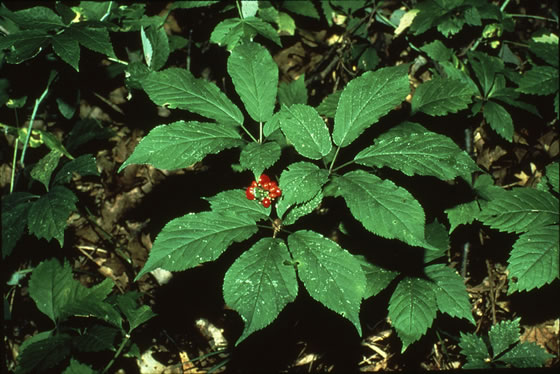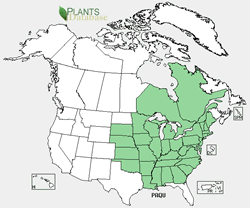Celebrating Wildflowers News
Long Live American Ginseng!
 American ginseng, Panax quinquefolius. Photo by Larry Stritch.
American ginseng, Panax quinquefolius. Photo by Larry Stritch.
 Range map of American ginseng, Panax quinquefolius. States are colored green where the species may be found. USDA PLANTS Database.
Range map of American ginseng, Panax quinquefolius. States are colored green where the species may be found. USDA PLANTS Database.
American ginseng (Panax quinquefolius) is a long-lived herbaceous perennial native to rich forests of the eastern United States. Prized for its fleshy taproot and similarity to the Asian medicinal plant Panax ginseng, American ginseng has been harvested both legally and illegally and exported to international markets since the early 1800s. Overharvests for the international market as well as other factors such as deer browse and habitat destruction are thought to have led to range wide population declines. Concerns regarding overharvest led to listing ginseng in Appendix II of the Convention for International Trade in Endangered Species (CITES) in 1975.
High prices for American ginseng roots in recent years have led to intense harvest pressure on public lands. Given that harvest is currently occurring allowed (by permit) on some national forest lands, it is imperative to assess the current management policy on these Forests in relation to population levels to determine if permitted harvest is consistent with long term sustainability of American ginseng.
Research has been initiated during Fiscal Year 2013 and will occur within the Forest Service’s Eastern Region (Monongahela National Forest in West Virginia and the Wayne National Forest in Ohio) and Southern Region (Pisgah and Nantahala National Forests, both in North Carolina). The research project title is “Development of strategies to assess population status, habitat occupancy, and sustainability of American ginseng (Panax quinquefolius) in eastern U.S. national forests.” The researchers are John Young, David Smith, and Tim King, all of the US Geological Survey, Leetown Science Center, in West Virginia.
The four phase study will determine distribution and occupancy of prime ginseng habitats; estimate population size and detection probability; determine population extent; and, collect plant material for genetic analysis to estimate genetic diversity and interbreeding. This information will be useful in determining the sustainability of American ginseng on the national forests under current management and needed future changes in management regimes to insure persistence and long term population viability for this important species.

